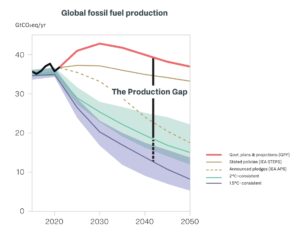CiTTi Magazine‘s resident columnist, Keith Mortimer, is reeling in the years and seeing double…
April 2019: Special measures
“Avoiding climate breakdown will require Cathedral thinking. We must lay the foundation while we may not know exactly how to build the ceiling. Sometimes we just simply have to find a way.” In a landmark speech to the Westminster Parliament, 16-year-old Greta Thunberg said that the UK was “very special.” This was “not only for its mind-blowing historical carbon debt, but also for its current, very creative, carbon accounting.”
Well, yes. Every government will mould, redefine and promote policies to keep power. It’s up to all of us to hold them to account. The UK’s coal-fired energy record isn’t glorious, but is it special? Global coal consumption reached a new high in 2022. Germany “ideally hoped” to phase out coal by 2030 but needed to greenlight a 19% increase. France had problems with nuclear power. Norway’s low-emission society hinges on its oil and gas exports just as nations – not least the UK – depend on its imports. Enlightened policies and COP pledges can’t compete with pandemics, conflicts and economic events.
It’s a scientific fact that politicians do not comprehend the words ‘exponential’ and ‘cumulative’. Once emitted, populist slogans may stick for a while, but greenhouse gases stick around for centuries. Strategies are announced, pledges made – but are the outcomes relevant to known laws of physical science, or more suited to the graveyard of our metaphorical Cathedral?
January 2030: the tipping point
Almost all countries have pledged that global CO2 emissions will have fallen by at least half since 1990. After its hottest-ever-recorded year, the planet should be halfway towards its 2030 target, respecting the remaining carbon budget and limiting warming to 1.5°C above pre-industrial levels.

November 2023: Another year, another UNEP report
The United Nations Environment Programme (UNEP)[1] has published its fourth “Production Gap” report. Sadly, governments are on track to produce more than twice the fossil fuel tonnage in 2030 than the agreed budget allows.
The UN Secretary General says “the report is a startling indictment of runaway climate carelessness. Governments are literally doubling down on fossil fuel production; that spells double trouble for people and planet.”
Will 2050 become the new 2030? Piously expressed targets won’t be met, because emissions from all of the coal, oil and gas already mined will be sufficient to overwhelm even a 2.5°C limit[2]. To guarantee energy security the UK has announced that new North Sea oil and gas licences will be awarded every year. Is your brain hurting yet?
January 1751: Leading the revolution
Up to the mid-18th century, the entirety of human progress was achieved with local help from animals, wind, waves, burning stuff, and prayers to every kind of religion. The UK led the Industrial Revolution, investing its Empire wealth into coal, iron, roads and water to accumulate untold fortunes. By 1850 the race was on. Her contribution reached six times the total of the fast-rising United States, who overtook her fifty years later. France, Germany, and Belgium followed behind.
The Earth has absorbed 273 years of every planet-warming gas while North America, Europe and the whole of Asia each have donated almost a third of the resulting 1.75 trillion tons. The UK has herself generated about 5%, while the rest of the world below the equator accounts for just 10%.[3] The typical Brit’s footprint today is over five tons/year. The Western world has also exported most of its production to willing nations. so that personal impact is nearer eight tons when adjusted for traded goods and services. Our US cousins rank twice as high, while citizens of the richest oil nations budget for 50 tons each, casually exceeding any equitable consumption.
The point of this nerve-jangling account is not as a blame game. We could build more temples, but no-one is coming to save us from the accidents of human history. The rest of the world is seeking privileges long-enjoyed by fellow-beings. If some have become used to overdrawing their Earthly account, that doesn’t justify future repetition; even if we write off past liabilities, there’s still a limited carbon budget to be shared fairly. Who will lead this revolution?
August 1945: Sea of troubles or salvation
The past eighty years have produced 85% of all the greenhouse gases that mankind ever made. Coincidentally, the world’s oceans have more slowly absorbed a similar tonnage since 1751. That’s 1.5 trillion of them. Hard to visualise: but here’s an awkward analogy. In August 1945 the city of Hiroshima was the site of an atomic explosion, indelibly seared into the memory of the human race. Researchers have calculated that the heating impact of greenhouse gas emissions is equivalent to exploding a Hiroshima-sized bomb every second. Others have put the number at four per second. The heat equivalent of at least 100,000 Hiroshima bombs is absorbed by the earth every single day.
Fortunately, 90% of this energy vanishes magically into the ocean, and is disregarded. The remaining fraction is plenty big enough to unsettle the planet’s airflows, landscapes and ice caps, but the ultimate climate bomb is lurking below. As the seas warm, the storage cycle is exponentially disrupted. Those trillion-plus tons of carbon buried in the mud? They start leaking out, triggering a cascade of climate hell, and calling in the forgotten, mind-blowing, tenfold carbon debt. Fossil fuels were humanity’s springboard to launch an age of prosperity (badly shared). Let’s hope Armageddon can be averted, but the cost lies on yesterday’s loan account, and every day of inaction it becomes less affordable.
December 2023: The world decides (again)
The incoming COP 28 presidency has one year, starting from now, to make a huge difference. As an oil-rich nation, how will its hosts rise to the occasion? Industry analysts estimate that from now till 2030 the UAE state company Adnoc plans to produce 3.4 billion tonnes of carbon. The company has pledged to “get serious about carbon capture” and reportedly plans to build annual capability of 10m tonnes by 2030. In 2030 the company’s own annual emissions are projected to rise to 684 million tons. Carbon capture technology may be valuable to maintain essential services where no alternative workable solutions are found. But it won’t even dent the indefinite expansion of the fossil fuel production gap.
Temples built from unscalable storage solutions, tricky offset theologies and wishful thinking will be swept away if the foundations of convenient belief are built on the shifting sands of empty promises. The ceiling’s already been reached. The persistent production gap impedes equitable energy transition. But given the chance, the world’s oceans can still be our salvation, offering an inexhaustible reservoir of renewable energy from the natural, sustainable resources that were always available while history unfolded. Or is that option still too hard to swallow?
Footnotes:
[1] https://productiongap.org/2023report/#2023downloads
[2] https://ourworldindata.org/co2-and-greenhouse-gas-emissions
[3] https://ourworldindata.org/grapher/cumulative-co-emissions





